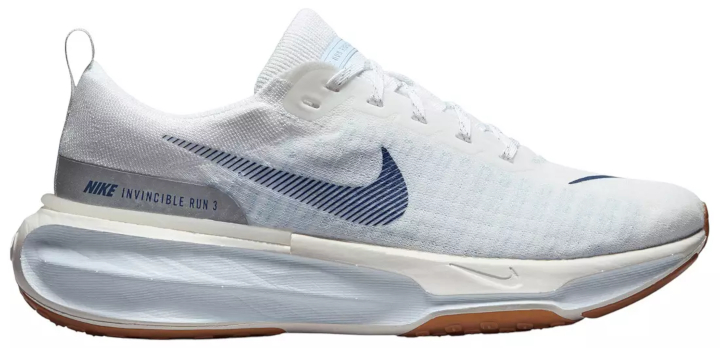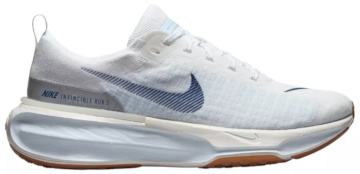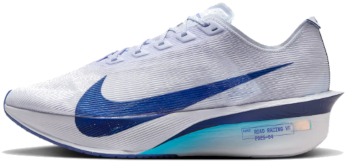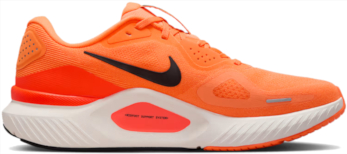Finding the right running shoes can completely change how your miles feel whether you’re chasing a marathon PR or lacing up for the first time. With so many models on the market, it’s easy to get overwhelmed by all the choices. That’s where Nike comes in. As one of the most trusted names in athletic footwear, they offer a deep lineup of shoes built for every type of runner, pace, and preference.
In this post, we’ll break down the top 5 Nike running shoes that blend style, comfort, and reliable performance. From max-cushioned trainers to speedy, responsive options, you’ll get a clear sense of what each shoe offers and which one matches your running style best. Let’s help you find the pair that makes every run feel better.
Table of Contents
- Understanding Your Running Style
- Criteria for Selecting Running Shoes
- The Top 5 Nike Running Shoes
- Conclusion
- Top 5 Nike Running Shoes FAQs

Understanding Your Running Style
Types of Runners
There are several types of runners, each with distinct characteristics and preferences:
- Casual Runners: Enjoy running for fitness and stress relief. They typically run at a comfortable pace and prioritize enjoyment over performance.
- Competitive Runners: Train to improve race times and achieve personal bests. They often participate in races and track their progress meticulously.
- Trail Runners: Prefer off-road running on natural terrain. They seek adventure and enjoy the beauty of nature while facing unique challenges like uneven surfaces and elevation changes.
- Long-Distance Runners: Focus on endurance events, such as half-marathons and marathons. They train extensively to build stamina and often follow specific training plans.
- Short-Distance Sprinters: Specialize in shorter races, typically under 400 meters. They focus on speed and explosive power, concentrating on training that enhances these attributes.
- Recreational Runners: Run for fun and social interaction, often participating in group runs or community events. Their primary goal is enjoyment rather than competition.
- Ultra-Runners: Participate in ultra-distance events, which exceed the traditional marathon distance. They require exceptional endurance and often train for a variety of terrains and conditions.
Each type of runner has unique motivations, training styles, and goals.
Importance of Choosing the Right Shoe
Choosing the right shoe is essential for comfort, performance, and long-term foot health. The right pair can help prevent injuries, support your specific movement patterns, and boost athletic efficiency, all while keeping your muscles and joints properly aligned. With a secure fit, improved balance, and better stability, the right footwear doesn’t just make your activity safer; it makes every run, workout, or walk feel smoother and more enjoyable.
Criteria for Selecting Running Shoes
Cushioning and Support
Cushioning and support play a huge role in how your running shoes feel and perform. Cushioning is all about impact absorption, softening each landing to protect your feet and joints, especially on hard surfaces or long-distance runs. The right amount of cushioning can help reduce fatigue and keep your stride feeling smooth and comfortable, even when the miles start to add up.
Support focuses on keeping your foot aligned and stable as you move. A well-structured shoe helps maintain a neutral position through every stride, reducing the risk of issues like overpronation, ankle sprains, or general strain. When you’re picking a pair, look for a combination of cushioning and support that matches your foot type, running style, and typical terrain. Getting that balance right can elevate your performance and make your runs feel more enjoyable overall.
Weight and Breathability
When selecting running shoes, weight and breathability are crucial factors.
- Weight: Lighter shoes can enhance performance, reducing fatigue during long runs. Look for shoes labeled as lightweight or designed for racing if speed is a priority. Heavier shoes may offer more cushioning and support, suited for longer distances or stability needs.
- Breathability: Proper ventilation helps regulate foot temperature and moisture, reducing the risk of blisters and discomfort. Choose shoes made with mesh uppers or breathable materials to ensure good airflow, especially in warmer climates or during high-intensity runs.
In summary, opt for lightweight shoes for speed and breathable materials for comfort to improve your running experience.
Traction and Durability
Traction and durability are two features that can make or break your running shoe experience. Traction is all about grip—how well the outsole keeps you steady on different surfaces so you’re not worrying about slips or awkward footing. Shoes with high-quality rubber and multidirectional lugs tend to perform best, giving you confidence whether the ground is wet, dry, or somewhere in between.
Durability, on the other hand, determines how well your shoes hold up over time. Strong materials in the upper, midsole, and outsole, along with reinforced areas and solid stitching, are good signs a shoe can handle consistent mileage. When you choose a pair that excels in both traction and durability, you’re not just getting better performance; you’re also getting a safer, more reliable running experience.
The Top 5 Nike Running Shoes
Best Overall
— Nike Pegasus 41 —
The Nike Pegasus 41 earns its spot as one of the best all-around running shoes in Nike’s lineup thanks to its blend of comfort, versatility, and everyday performance. The ReactX cushioning, paired with dual Air Zoom units, delivers a ride that’s both responsive and well-cushioned, making it suitable for everything from easy miles to longer training days. Add in the lightweight, breathable engineered mesh upper, and you get a snug, comfortable fit that stays cool even when the miles start to stretch out.
What really cements the Peg 41’s reputation is its durability and reliability. The waffle-inspired rubber outsole grips well across a variety of surfaces, giving you stable footing whether you’re running on pavement, packed dirt, or something in between. With a long history of consistent quality and praise from casual runners and competitive athletes alike, the Pegasus series continues to be a go-to choice, and the 41st edition keeps that legacy going strong.
Most Comfortable
— Nike Invincible 3 —
The Nike Invincible 3 has earned its reputation as the most comfortable running shoe in Nike’s lineup, and it all comes down to its thoughtful design and standout cushioning. With a thick layer of ZoomX foam underfoot, the ride feels incredibly soft yet springy, giving you top-tier shock absorption and a lively energy return that keeps your legs feeling fresher for longer. The breathable Flyknit upper adds to the comfort, wrapping the foot securely while letting air flow freely on warm or extended runs.
What really rounds out the experience is the shoe’s wide, stable platform, which adds confidence no matter your running style. Whether you’re cruising through easy miles or taking on longer sessions, the Invincible 3 helps reduce fatigue and delivers a smooth, supportive ride from start to finish. It’s comfort-first design done right.
SHOP AT DICK’SBest for Marathon
— Nike Alphafly 3 —
The Nike Alphafly 3 stands out as the go-to Nike shoe for marathon runners, thanks to its blend of cutting-edge design, race-day speed, and long-distance comfort. With its ultra-light construction and ZoomX foam midsole, boosted by dual Air Zoom pods, the ride feels incredibly energetic and responsive. That lively bounce helps conserve your legs late in the race, making it easier to hold pace when fatigue starts to creep in.
The carbon fiber plate adds even more efficiency, encouraging a smooth, snappy toe-off that improves running economy mile after mile. Up top, the breathable upper wraps the foot securely without trapping heat, which is crucial during long hours on the course. When you combine speed, support, and advanced materials in one package, it’s easy to see why the Alphafly 3 is a favorite among marathoners looking for every performance advantage they can get.
Best for Racing
— Nike Vaporfly 4 —
The Nike Vaporfly 4 has earned its reputation as Nike’s top racing shoe thanks to its cutting-edge design and lightning-fast feel. Built with an ultra-light construction, it helps you pick up speed effortlessly while reducing fatigue over longer distances. The full-length carbon fiber Flyplate gives each stride a powerful, propulsive snap, making it easier to hold race pace without burning through your energy too quickly.
The ZoomX cushioning adds to the magic by delivering exceptional comfort and responsiveness, keeping your legs feeling fresher deep into the race. Its sleek, aerodynamic shape helps minimize drag, giving you every possible edge when it comes to efficiency. For runners chasing PRs and wanting a shoe that maximizes speed from start to finish, the Vaporfly 4 is tough to beat.
Best for Support
— Nike Structure 26 —
The Nike Structure 26 stands out as Nike’s top stability shoe because it blends reliable support with a smooth, comfortable ride. With its higher stack height and built-in midfoot support system, it delivers dependable arch support that helps guide your stride and reduce overpronation. The updated ReactX foam midsole adds a layer of plush cushioning while still giving you a responsive feel, making daily runs more enjoyable and less taxing on your legs.
Underfoot, the durable outsole provides excellent traction across different surfaces, so you feel steady and secure whether you’re tackling long miles or quick errands. The breathable upper keeps airflow moving and maintains a snug, comfortable fit throughout your run. If you’re looking for a stability shoe that feels supportive without sacrificing comfort or responsiveness, the Structure 26 is an easy choice.
Conclusion
Choosing the right pair of running shoes isn’t just a box to check; it’s the difference between a run that feels effortless and one that feels like work. The five Nike models we highlighted each bring something unique to the table, whether you’re a marathon veteran, a weekend jogger, or someone easing into a new fitness routine. Nike has a knack for tailoring performance features to different running styles, and these picks show just how much variety you can tap into.
Once you understand what each shoe is built to do, picking the right one becomes much easier. Look for the model that matches your goals, supports your stride, and fits the way you actually run—not the way you think you should run. When you land on the right pair, everything clicks—better comfort, smoother performance, and a more enjoyable experience from the first mile to the last.
Heads up: As an Amazon Associate, we earn from qualifying purchases. (This content was created with the help of AI.)
Top 5 Nike Running Shoes FAQs
How do I determine my foot type?
To determine your foot type, follow these steps:
Wet Foot Test: Wet the bottom of your foot and step onto a piece of paper or a flat surface. Analyze the imprint:
- Flat Foot: If your footprint shows almost the entire foot, you likely have flat feet.
- Normal Arch: If you see a moderate curve in the middle with some connection, you have a normal arch.
- High Arch: If there’s a very narrow connection, you likely have high arches.
Shoe Wear Pattern: Examine the wear on your shoes:
- Flat Feet: Excessive wear on the inside edge.
- Normal Arch: Even wear across the shoe.
- High Arch: Wear concentrated on the outer edges.
Foot Flexibility Test: Sit down and have someone lift your foot while you relax. If your foot bends easily, you may have flat feet. If it stays rigid, you might have a high arch.
Consult a Professional: For a definitive assessment, visit a podiatrist or a specialized running store for a gait analysis.
Can I use running shoes for other sports?
Pros of Using Running Shoes for Other Sports:
- Comfort: Running shoes provide cushioning and support, making them comfortable for various activities.
- Lightweight: Most running shoes are designed to be lightweight, allowing for better agility and speed.
- Breathability: Many running shoes feature breathable materials, helping to keep feet cool and dry.
- Versatile: Suitable for multiple activities like walking, gym workouts, and casual sports.
- Injury Prevention: Good running shoes can help reduce the risk of injuries with proper arch and heel support.
Cons of Using Running Shoes for Other Sports:
- Lack of Support: Running shoes may not provide the lateral support needed for sports involving quick side-to-side movements.
- Traction Issues: Tread patterns may not be ideal for sports played on different surfaces, leading to slips or falls.
- Sole Durability: Running shoes are designed for forward motion, which can wear them down faster in sports requiring multidirectional movements.
- Inadequate Protection: They may not offer sufficient protection for sports involving impacts or hard surfaces.
- Specificity: Some sports have specific footwear requirements that enhance performance, which running shoes may not meet.
How often should I replace my running shoes?
Replace your running shoes every 300 to 500 miles, or approximately every 6 to 12 months, depending on your running style and the terrain. Monitor for signs of wear, such as reduced cushioning, uneven soles, or discomfort during runs, to determine when it’s time for a replacement.
You may also like:





